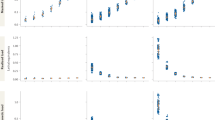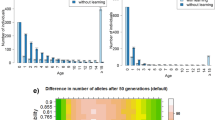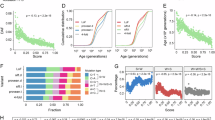Abstract
How great a genetic load can a population tolerate ? This subject has recently been discussed by several authors1–5. We believe that a most important point can be stated briefly: because most organisms produce far more offspring than are necessary to maintain a constant population density, and because population densities remain, very roughly, constant, many individuals die before they are mature; it does not matter whether they die of starvation, accidents or from genetic ailments; the population can still maintain itself. It is not so much that there is a genetic load which might threaten the species, but that there is an ecological load, resulting from density regulation, which because it must, as Darwin noted, produce natural selection, gives rise to the apparent genetic load. A population will be able to tolerate what seems to us a considerable genetic load, without being, on that account, in any danger of extinction. The genetic load is, for the most part, merely an expression of the fact that not all genotypes are equally viable when the population becomes crowded. Many individuals have to die in the process of density regulation, and if those which die differ genetically from those which survive, we will observe a “genetic load”. This is the crux of the Malthus—Darwin concept of selection. This does not of course apply to genetic conditions which are markedly disabling at all population densities; there must be a decided limit (although a fairly high one, for the dead individuals simply leave more food or space for others, which otherwise would die) to the number of these which a population can contain. We suggest the term “loaded” for this last kind of selection.
This is a preview of subscription content, access via your institution
Access options
Subscribe to this journal
Receive 51 print issues and online access
$199.00 per year
only $3.90 per issue
Buy this article
- Purchase on SpringerLink
- Instant access to full article PDF
Prices may be subject to local taxes which are calculated during checkout
Similar content being viewed by others
References
Lewontin, R. C., and Hubby, J. L., Genetics, 54, 595 (1966).
Sved, J. A., Reed, T. E., and Bodmer, W. F., Genetics, 55, 469 (1967).
King, J. L., Genetics, 55, 483 (1967).
Milkman, R. D., Genetics, 55, 493 (1967).
Feller, W. B., Genet. Res., Cambridge, 9, 1 (1967).
Williamson, M. H., Nature, 180, 422 (1957).
Turner, J. R. G., Proc. Roy. Soc., B, 169, 31 (1967).
Kojima, K., and Yarbrough, K. M., Proc. US Nat. Acad. Sci., 57, 645 (1967).
Levene, H., Amer. Naturalist, 87, 257 (1953).
Ford, E. B., Ecological Genetics, chap. 2 (Methuen, London, 1964).
Bentvelzen, P., Genetica, 34, 229 (1963).
Harding, J., Allard, R. W., and Smeltzer, D. G., Proc. US Nat. Acad. Sci., 56, 99 (1966).
Cain, A. J., and Sheppard, P. M., Amer. Naturalist, 88, 321 (1954).
Cain, A. J., and Sheppard, P. M., Amer. Naturalist, 90, 202 (1956).
Author information
Authors and Affiliations
Rights and permissions
About this article
Cite this article
TURNER, J., WILLIAMSON, M. Population Size, Natural Selection and the Genetic Load. Nature 218, 700 (1968). https://doi.org/10.1038/218700a0
Received:
Issue date:
DOI: https://doi.org/10.1038/218700a0
This article is cited by
-
Standing genetic variation fuels rapid adaptation to ocean acidification
Nature Communications (2019)
-
Genetical composition, temperature, density and selection in an enzyme polymorphism
Heredity (1977)
-
Selection of B chromosomes in Secale cereale and Lolium perenne
Heredity (1975)
-
Mutation and population size
Heredity (1973)
-
The effect of population structure on the success of insect introductions
Heredity (1969)



